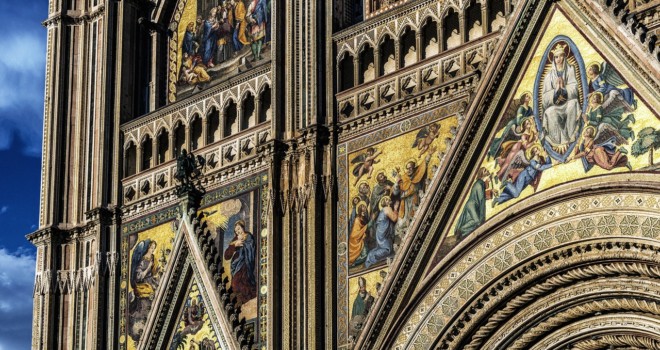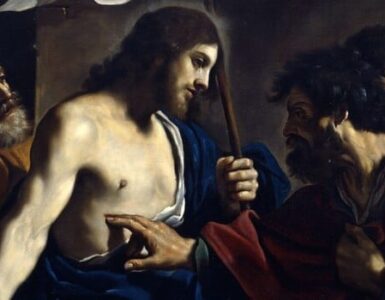When I hear people say things like “God told me this” or “I think the Spirit is saying that,” I just shake my head. The Lord doesn’t work with me that way. In fact, more often than not, my prayers are generally met with yawning silence — or at least what I interpret as yawning silence. In my head, I know he hears me. In my heart, I know he answers me, one way or other.
But in my day to day experience? Crickets. Mainly crickets.
That was especially true when I was struggling with my vocational direction in the years after I joined the Church. At first, it seemed obvious: I was young, single, male, devout — and the Church needed more priests. So, duh, go to seminary, already! Become a priest! Q.E.D. (or something else equally Latin-y for emphasis)!
Not so fast. I met roadblock after roadblock, despite praying up a storm. “God, here I am,” I’d complain. “Ready to come to the Church’s rescue! What’s the holdup? Why the hassle?” (chirp, chirp) It seemed like he wasn’t answering my prayers – that he was ignoring my generous offers to pursue ordination or maybe just overlooking them. But, that couldn’t be: He’s God, after all. What else could possibly be going on?
Then I met Nancy. We fell in love, married, and welcomed a van full of terrific kids over the years. “Ah,” I said to myself after some time. “Now I get it.”
Sound familiar? Maybe you, too, had a turbulent vocational journey. Maybe your path was equally serpentine and mystifying — maybe it still is now. Or maybe yours was more like a beeline. Regardless, today is our day to look at a couple saintly intercessors with definite discernment fortes, although with opposite emphases.
Saint Clelia Barbieri
Saint Clelia Barbieri is from the “God told me” side of vocational assuredness. She was born in 1847 near Bologna, Italy.
Hers was a pious, working class family, but their poverty meant that everybody had to chip in. Hence, the youthful Clelia received training from her mother in spinning, sewing, and weaving, although the training was coupled with a thorough grounding in the Faith and sound habits of prayer. She grew up toiling alongside her family while contemplating the things of God, and so when she asked her mother, “How can I become a saint?” she already had her answer.
She was already doing it.
Because of her solid early formation and spiritual maturity, Clelia was allowed to make her first Holy Communion when she turned eleven (at a time when most Catholics had to wait until near adulthood), and she began experiencing spiritual ecstasies and rhapsodic episodes. Even so, she carried on as before in her labors, and her selfless charity and cheerfulness made her a favorite among her co-workers and peers.
Clelia rebuffed all offers of marriage, choosing instead to become a lay leader in the Christian Catechism Workers movement, spreading the Gospel among the sick and poor. A coterie of like-minded women in the movement gathered around Clelia, and in 1868 the saint — a mere 21 years old — organized them into a community dedicated to prayer and apostolic works.
This band was the nucleus of what would become known as the Little Sisters of the Mother of Sorrows, a religious community that not only outlasted Clelia’s premature death from tuberculosis on July 13, 1870, but has continued to thrive in Italy and around the world. St. Paul VI beatified Clelia in 1968, and St. John Paul II canonized her in 1989.
So here’s a women who seemed to have no doubts whatsoever about her religious calling from her youngest years — a vocational assurance that led her to become, according to her Vatican biography, the “youngest founder of a religious order in the history of the Church.” Fine — and we count on her prayers for clarity and discernment as we bumble along in our own more pedestrian spiritual meanderings.
Saint Henry II
But is there anybody else up there that we can, you know, relate to more? Some saintly somebody that has a history of fits and starts more comparable to our own?
Why, yes, you’re in luck — and his feast happens to coincide with Clelia’s, July 13th.

It’s St. Henry II, ruler, warrior, and religious reformer. Of royal German blood, Henry was groomed to rule, but he had a natural disposition oriented to prayer and piety. He inherited the imperial title in 1002, Pope Benedict VIII crowned him Holy Roman Emperor in 1014, and Henry did his best to balance the demands of his office with the demands of the Gospel until his death in 1024.
Yet, Henry’s true vocation was to the married state, though not fatherhood. In 998, he wed Cunigunde of Luxembourg (herself a saint) and Henry was truly devoted to his queen. Yet, it was a childless marriage, and there’s some speculation that the couple’s lack of issue was due to their taking vows of perpetual continence. This would help explain the tradition that Henry, exasperated by the demands of statecraft, sought to abandon his throne by vowing obedience to the abbot of St. Vanne at Verdun. “The abbot accepted the emperor’s obedience,” reads Coulson, “but, in return, commanded him to go on ruling the Empire.”
It’s because of this story that St. Henry has been adopted as the patron of those rejected by religious orders. Nonetheless, despite apparent vocational wavering this way and that, Henry persisted in pursuing holiness and he won the crown of sanctity — even in the midst of bearing the crown of rulership.
That’s the kind of perseverance at the heart of all Christian callings, regardless of whether we’re Clelias with straight vocational trajectories, or Henrys with jagged ones. It’s summed up well in the first reading from Henry’s memorial Mass. “You have been told,” writes Micah, “what the LORD requires of you: Only to do the right and to love goodness, and to walk humbly with your God.”
Now there’s a divine directive that we can bank on, crickets or no crickets.














